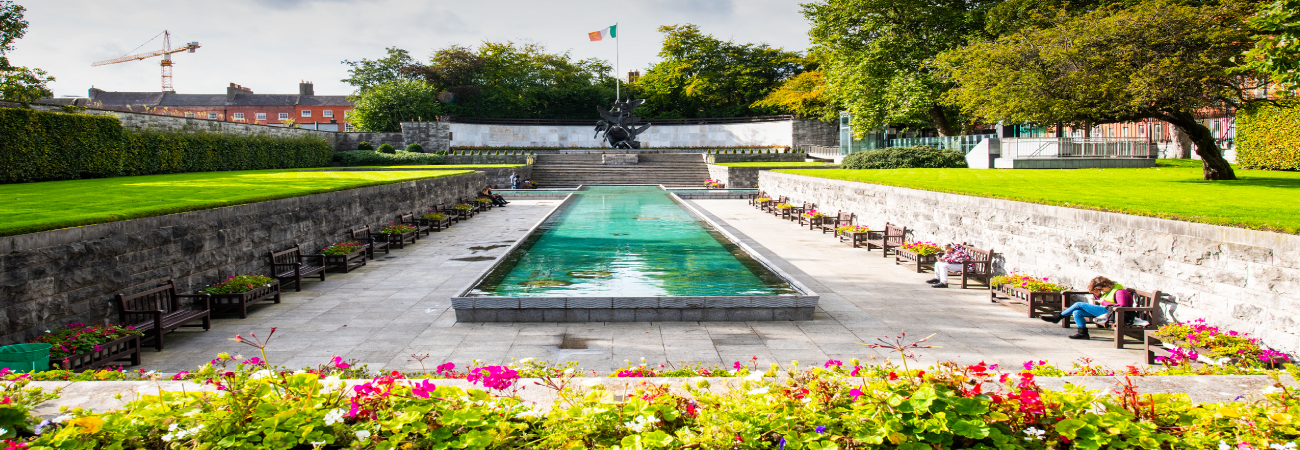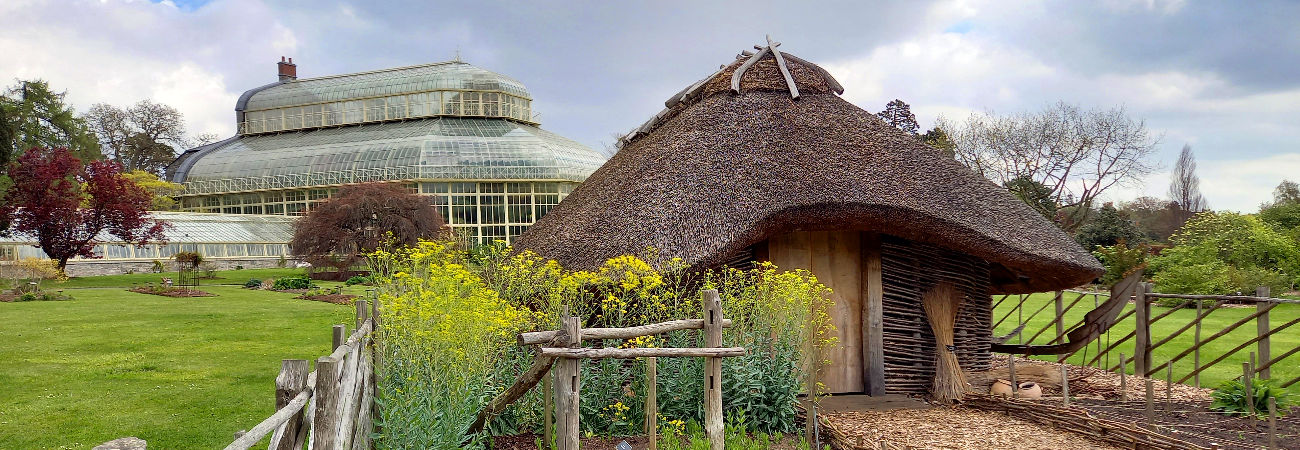Take a stroll through Central Dublin to discover hidden and historical outdoor gems. These parks and gardens are all within a 10 minute walk of The Castle Hotel in Dublin's city centre. Perfect for a short walk during your city break in Dublin.
Clockwise from left....
1. Garden of Remembrance
The Garden of Remembrance is located only seconds away from our front door. Opened first in 1749 as a pleasure garden which charged an entrance fee, it was then redesigned and opened to the public during the 50 year anniversary of the Easter Rising in 1966. It was dedicated by Eamon de Valera “to all those who lost their lives in the cause of freedom” and commemorates the brave freedom fighters dating back to the 1798 rebellion of the society of United Irishmen.
The garden has multiple seating benches at different points throughout, allowing you to enjoy the water feature, architecture, statue and landscaping from different views. The statue, which was later added in 1971, depicts the Irish mythological story of The Children of Lir and represents transformation. The water feature is a sunken pool in the shape of a crucifix and has mosaics of broken weapons in the water.
In 2011, Queen Elizabeth II made an historic visit to lay a wreath for those who gave their lives to fight for Irish freedom further unifying the cross-border dedication to ensuring peace among nations.
Many royal dignitaries from across the world have visited the garden as part of their tours of Dublin, most recently the Duke and Duchess of Cambridge in 2020 and the King and Queen of Sweden in 2019.
2. Mountjoy Square
Mountjoy Square park, located less than 5 minutes away from the doors of The Castle Hotel, is one of five Georgian squares in Dublin. It is, however, Dublin’s only true Georgian park as all four of its sides are of equal length.
The park itself has plenty of amenities including a basketball court, football pitch, playground and beautiful greenspace to sit and relax.
Even with its beautiful features there is also some hidden history. There have been some well-known residents who have lived here from Arthur Guinness, to famous poets and some of the founding members of the Irish Citizen Army. Throughout history, this park has also held many important meetings for the Irish citizens, including planning for the Easter Rising and very early meetings of the Dáil.
On the streets around the park, you can still identify some small historical features such as ornate coal hole covers to mud scrapers outside the doors from the late 1800’s and the designs of many lampposts in the area hail from the early 1900’s.
3. Blessington Street Basin
A 3 minute stroll northwest of the Castle Hotel you can find an oasis in the hustle and bustle of the city. Blessington Street Basin was opened in 1810 as a drinking reservoir named Royal George Reservoir in honour of King George III. The reservoir was not large enough in 1869 to serve the growing population so it was then used to serve the Powers’ and Jameson’s distilleries. It was retired fully as a reservoir in the 1970’s and after restoration work it was opened as a public park in 1994.
This hidden gem is now the home to many species of wildlife and serves as a bird habitat.
A beautiful peaceful place to sit and relax, you can see a stunning lodge house built in 1811, watch the birds fly above your head or simply witness the beautiful fish swim freely.
4. The Hungry Tree at King’s Inn Park
This infamous tree sits just inside the south gate of the grounds of King’s Inn. The park itself is located on Constitution Hill about a 10 minute walk from the Castle Hotel.
The tree is a London plane and was planted next to a cast iron bench dating from the early 1800s. Over the years, as the tree has grown, it has completely enveloped the bench and is said to be “eating it”, hence the term the Hungry Tree!
The tree once described as “an unremarkable specimen mediocre in appearance” is now 21 metres in height and 3.47 metres in width (correct as of 2020) and estimated to be between 80-120 years old.
Regularly included in secret guidebooks of Dublin and considered a hidden gem, it has now become a much loved tourist attraction and photo opportunity. It is available to visit while the Kings Inns grounds are open.
5. Royal Canal Bank Linear Park
A widely unknown stretch of greenery, this linear park walk leads from the Blessington Basin (as previously described), through this amazing 210 year old cast iron door to the Irish Volunteer Monument in Phibsboro. The walkway is built on top of the land which was once a canal linking Dublin to the Shannon River, and includes a playground and outdoor gym equipment.
The Broadstone Line of the Royal Canal was built in the late 1700s in a bid to connect Dublin to the Midlands of Ireland. Opening in 1802 the Broadstone line connected Dublin to Newcastle but later in 1817 was fully operational connecting directly to the Shannon. Broadstone quickly became the major harbour for links between the city and midlands. While canal transport was functional it was becoming outdated by the road and railway transport. In 1845 The entire Royal Canal and all of its harbours were bought by a new railway company “The Midland and Great Western Railway Company”. The company had no interest in preserving the canal, instead wanting to convert its harbours to railway stations and using its flatlands for railway tracks. Gradually over the years the Broadstone canal line was decommissioned and filled in, leaving only the names of the roads which took its place, to remind us where this great waterway once stood.
One of the stretches being the The Royal Canal Bank Road and the linear park which stands alongside it.
The Irish Volunteer Monument at the the Phibsboro end of the walkway, actually stands on the road which would have once housed the humpback Blacquiere Bridge. It was constructed to remember members of the Dublin Brigade of the Irish Volunteers who fought and died during the Easter Rising and the War of Independence. The monument shows a kneeling soldier poised for battle and underneath him stone carvings depicting scenes from mythological and ancient Irish history such as Cuchulainn and Brian Boru.
Phibsboro is a thriving neighbourhood of North Dublin, home to popular cafés and pubs such as Two Boys Brew, Bernard Shaw, Yoga Hub, Bang Café and more. James Joyce gave Phibsborough (as it is also known as) the nob in his Ulysses.


